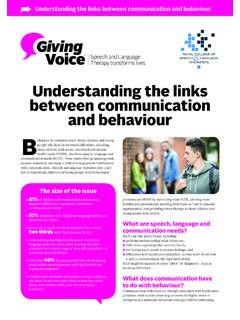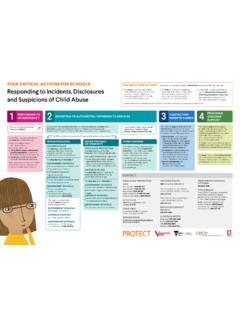Transcription of School Connectedness: Strategies for Increasing …
1 School connectedness Strategies FOR Increasing PROTECTIVE FACTORS AMONG YOUTH Suggested Citation: Centers for Disease Control and Prevention. School connectedness : Strategies for Increasing Protective Factors Among Youth. Atlanta, GA: Department of Health and Human Services; 2009. Additional Copies: To download or order a free copy of this publication, go to 1 Families, schools, and communities all need to work together to create an environment that facilitates healthy development of children and adolescents. 2 Efforts to improve child and adolescent health typically have featured interventions designed to address specific health risk behaviors, such as tobacco use, alcohol and drug use, violence, gang involvement, and early sexual initiation. However, results from a growing number of stud ies suggest that greater health impact might be achieved by also enhancing protective factors that help children and adolescents avoid multiple behaviors that place them at risk for adverse health and educational outcomes.
2 Enhancing protective factors also might buffer children and adolescents from the potentially harmful effects of negative situations and events, such exposure to violence. Protective factors include personal characteristics such as a positive view of one s future; life conditions such as frequent parental presence in the home at key times ( , after School , at dinner time);2 and behaviors such as active participation in School School connectedness is a particularly promising protective factor. This publication defines and describes the components of School connectedness and identifies specific actions that schools can take to increase School connectedness . What Is School connectedness ? In 2003, the Wingspread Conference was sponsored by CDC s Division of Adolescent and School Health and the Johnson Foundation to bring together key researchers and representatives from the education and health sectors to assess the state of knowledge about School connectedness and its effect on health and education outcomes.
3 Through an extensive review of research and in-depth discussions, the interdisciplinary group defined School connectedness and identified, in the Wingspread Declaration on School Connections,4 Strategies that schools could implement to increase it. School connectedness was defined as the belief by students that adults in the School care about their learning as well as about them as individuals. Because studies indicate that individual students feelings of being connected to School are influenced by their peers as well as by adults,3,5 this publication has expanded that definition to include peer influence. Risk Factors are individual or environmental characteristics, conditions, or behaviors that increase the likelihood that a negative outcome will occur. Protective Factors are individual or environmental characteristics, conditions, or behaviors that reduce the effects of stressful life events; increase an individual s ability to avoid risks or hazards; and promote social and emotional competence to thrive in all aspects of life now and in the School connectedness is the belief by students that adults and peers in the School care about their learning as well as about them as individuals.
4 3 How Was This Publication Developed? The Strategies and actions recommended in this publication are based on the Wingspread Declaration on School Connections and a synthesis of School connectedness and related research from the fields of education, health, psychology, and sociology. Materials in the review include peer-reviewed journal articles, books, reports from govern ment agencies and non-governmental organizations, and Web sites. Information from these sources was summarized to identify policies and practices that demonstrated an impact on students sense of connectedness to School . In addition, recommendations were informed by the opinions of expert researchers, public health practitioners, and educators. This process identified six evidence-based strate gies that could be implemented to increase students sense of connectedness to School , along with specific actions that can be taken to implement each of the Strategies . The audiences for this publication include School administrators, teachers, support staff, and parents, as well as others inter ested in promoting School connectedness .
5 Each audience, however, has different roles and responsibilities related to garnering support for, and implementing, these actions. Only a limited number of studies have evaluated the impact of specific actions designed to foster School connectedness on health and academic outcomes. Therefore, many of the actions suggested in this publication are recommended on the basis of a single study of interventions that imple mented multiple actions simultaneously, and it is difficult to isolate which components of the overall intervention contributed to observed positive changes in behavior and outcomes. However, actions were included only if CDC scientists and the panel of advisors for this project believed there was a logical connection between the action and School connectedness ; the action was consistent with recog nized standards of practice and feasible for most schools to implement; and the action was considered highly unlikely to be harmful to students. 4 Why Is School connectedness Important?
6 Students are more likely to engage in healthy behaviors and succeed academically when they feel connected to School . The National Longitudinal Study of Adolescent Health looked at the impact of protective factors on ado lescent health and well-being among more than 36,000 7th 12th grade students. The study found that family, School , and individual factors such as School connectedness , parent-family connectedness , high parental expectations for academic achievement, and the adolescent s level of involvement in religious activities and perceived importance of religion and prayer were protective against a range of adverse ,6,7 School connectedness was found to be the strongest protective factor for both boys and girls to decrease substance use, School absenteeism, early sexual initiation, violence, and risk of unintentional injury ( , drinking and driving, not wearing seat belts).2 In this same study, School connectedness was second in importance, after family connectedness , as a protective factor against emotional distress, disordered eating, and suicidal ideation and ,3,6 Research has also demonstrated a strong relationship between School connectedness and educational outcomes, 8 12 including School attendance;10 staying in School lon ger;11 and higher grades and classroom test ,12 In turn, students who do well academically are less likely to engage in risky ,14 Compared with students with low grades, students with higher grades are signifi cantly less likely to carry a weapon, smoke cigarettes, drink alcohol, and have sexual What Are the Factors that Can Increase School connectedness ?
7 Adult support : School staff can dedicate their time, interest, attention, and emotional support to students. Belonging to a Positive Peer Group: A stable network of peers can improve student perceptions of School . Commitment to Education: Believing that School is important to their future, and perceiving that the adults in School are invested in their education, can get students engaged in their own learning and involved in School activities. School Environment: The physical environment and psychosocial climate can set the stage for positive student perceptions of School . 5 Adult support According to research by Blum and colleagues, children and adolescents beliefs about themselves and their abilities are shaped by the extent to which they perceive that the adults in their lives care about them and are involved in their Children and adolescents who feel supported by important adults in their lives are likely to be more engaged in School and In the School setting, students feel supported and cared for when they see School staff dedicating their time, interest, attention.
8 And emotional support to Students need to feel that adults care about them as individuals as well as about their academic Smaller schools may encourage more personal relationships among students and staff and allow for personalized 19 Schools can form schools-within-a- School or create multidisciplinary teams of teachers in which a small number of teachers know each student and can ensure that every student has an identified Belonging to a Positive Peer Group Students health and educational outcomes are influenced by the characteristics of their peers, such as how socially competent peer group members are or whether the peer group supports pro-social behavior ( , engaging in School activities, completing homework assignments, helping others).21 Being part of a stable peer network protects students from being victimized or However, if the norms in the peer group support socially irresponsible behavior ( , bullying, graffiti), students are less likely to be involved in School activities, and their sense of connectedness to School , achievement levels, and health behaviors can ,22 Strong interpersonal skills enable students to maintain healthy relationships.
9 Students who report feeling most connected to School also report having the most friends at School and having friends from several different social groups that are integrated by race and gender. Conversely, those students who report feeling less connected to School have more friends from outside School than inside or are socially isolated, reporting few friends either inside or outside of 6 Commitment to Education It is important that both students and adults are committed to learning and are involved in School activities. Students dedication to their own education is associated with the degree to which they perceive that their peers and important adults in their lives 1) believe School is important and 2) act on those Students who are personally invested in School and believe that a good education is important for reaching their life goals spend more time on homework and in School activities and have an increased sense of connectedness to ,18,21,24,25 Students who are engaged in their own education exhibit behavioral traits such as persistence, effort, sustained attention to tasks, and a higher level of preference for challenge and School staff who are dedicated to the education of their students build School communities that allow students to develop emotionally, socially, and mentally, as well as academically.
10 Committed adults engage students in learning, foster mutual respect and caring, and meet the personal learning needs of each ,15,18 School Environment connectedness is enhanced by a healthy and safe School environment and a supportive psychosocial climate. A clean and pleasant physical environment ( , one free from graffiti) raises expectations for safety and sets the stage for positive, respectful The psychosocial climate at School is influenced by such factors as policies related to discipline, opportunities for meaningful student participation, and teachers classroom management practices. Research indicates that in schools with a harsh and punitive discipline climate, student connectedness is ,18 A positive School environment, often called School climate, is characterized by caring and supportive interpersonal relationships; opportunities to participate in School activities and decision-making; and shared positive norms, goals, and ,28 One study found that schools with a higher average sense-of-community score ( , composite of students perception of caring and supportive interpersonal relationships and their ability to be autonomous and have influence in the classroom) had significantly lower average student drug use and delinquency.














